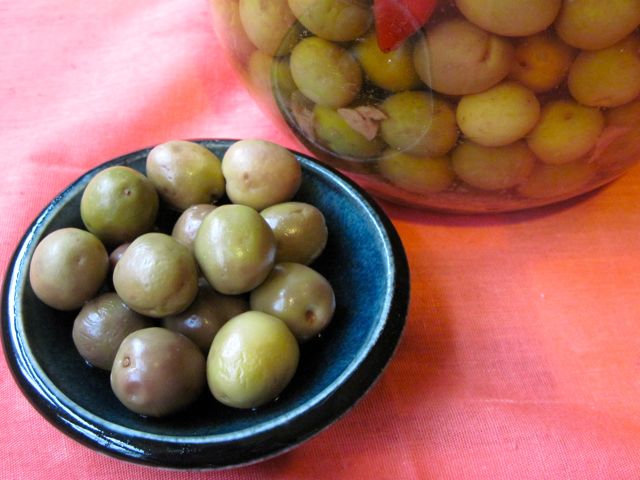
reference-image, l
(post, Linda Ziedrich)
To my regret, I never got around to curing the fruit of the huge old olive trees on my parents’ California ranch, which they have long since sold. Like many other gardeners in the Pacific Northwest, I now have my own little olive tree, of the hardy Arbequina variety, and I await the first crop with greedy anticipation. Last year, though, I got to wondering: In the age of the Internet and overnight delivery, did I have to wait? Could I buy some fresh olives to cure at home? In fact, I could. For less than $30, I had 10 pounds of green Sevillanos delivered to my door in early September. I looked them over carefully; you don’t want to cure olives that are bruised or otherwise damaged. Nearly all were perfect. I grabbed my copy of the University of California’s Olives: Safe Methods for Home Pickling, and studied up. [%image olives float=right width=300 caption="It's not difficult to cure your own olives."] There are many ways to cure olives. The best choice depends on the variety, whether the olives are green or ripe, how you want to store them, and how long you’re willing to wait before you eat them. I chose the method that the booklet calls Sicilian-style — that is, simple brining — for most of the olives. For the rest, I chose a lye cure followed by a shorter brining. For the Sicilian-style olives, I filled two glass jars, one gallon-size and one three-quart-size, with olives, hot peppers, chopped garlic, bay leaves, and fennel umbels, and then I added a brine made of 1 cup pickling salt, 1 gallon water, and 1 pint red-wine vinegar. The remaining two quarts of olives I treated with lye — Red Devil, which you might use to clean out a kitchen drain — mixed with water. The olives soaked in the lye water for about 12 hours, and then I repeatedly rinsed them and soaked them in pure water for about 30 hours, to remove the lye. At this point the olives had lost their natural bitterness, but they still needed to ferment to develop their flavor and texture. I mixed up a brine with the same ratio of salt to water as before, but this time I left out the vinegar. Presumably because lye kills the lactic-acid-forming bacteria on the olives, the recipe told me I needed to add a starter. I used a little brine from a jar of unpasteurized fermented cucumber pickles. Two months later, the lye-treated olives were already tender, but they also tasted of dill and cucumbers from the pickle brine. So, though the recipe didn’t call for seasonings, I added hot pepper, garlic, bay, and thyme. A week or so later, these olives were delicious, and my husband and I started eating and sharing them. Now we have finished off the lye-treated olives and are waiting for the Sicilian-style ones, which have lost most of their bitterness. I actually like the slight bitterness that remains, but the texture is still a little too chewy. We’ve just reached the minimum curing time for these olives — about four months. We’ll probably wait another two weeks or so before we start eating them. Olives includes recipes for other curing methods, and none of these methods is more complicated than the two I tried. Curing olives, like making other sorts of pickles, is not only possible for people who don’t grow their own; it’s also easy. p(blue). Culinate editor's note: This post also appeared on Linda Ziedrich's blog, A Gardener's Table.

reference-image, l

olives, l